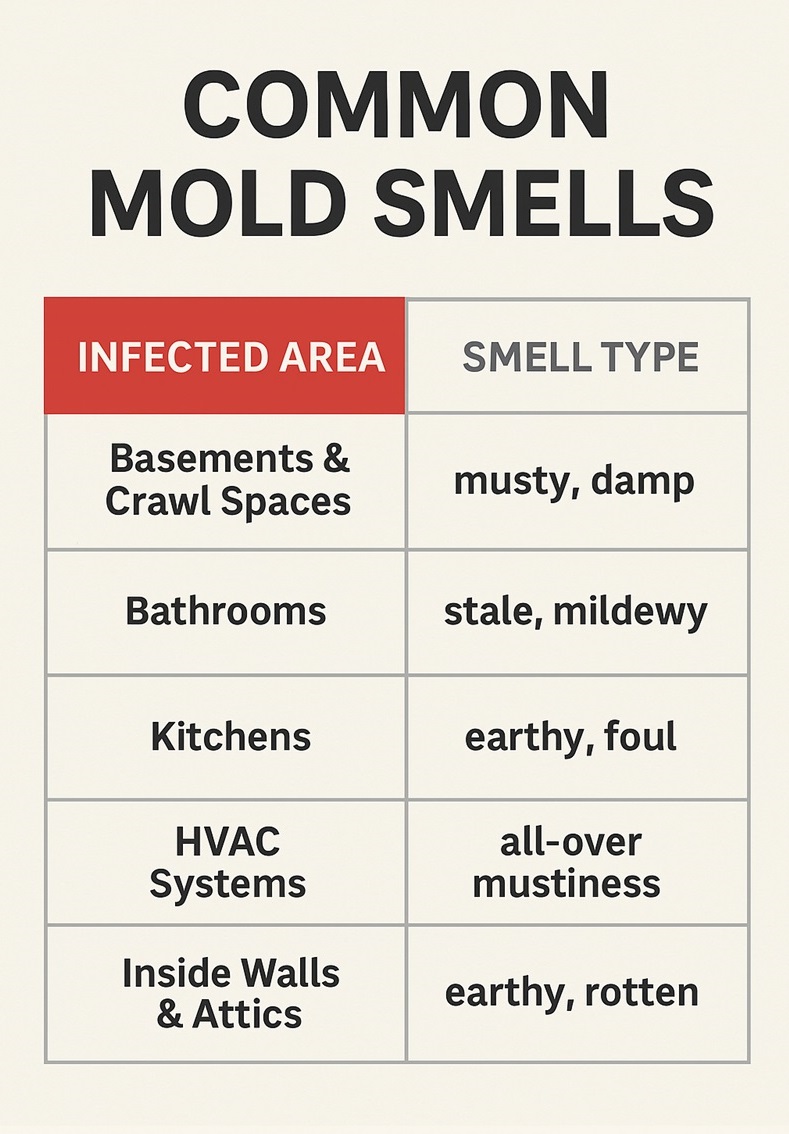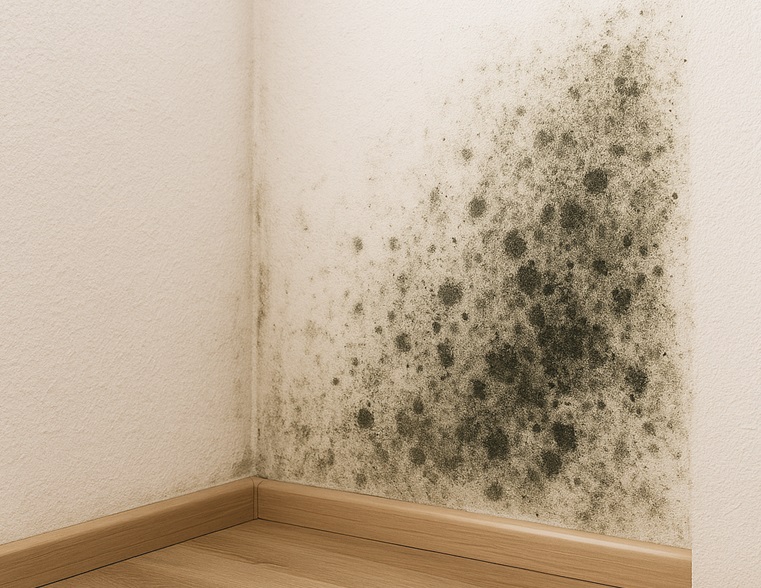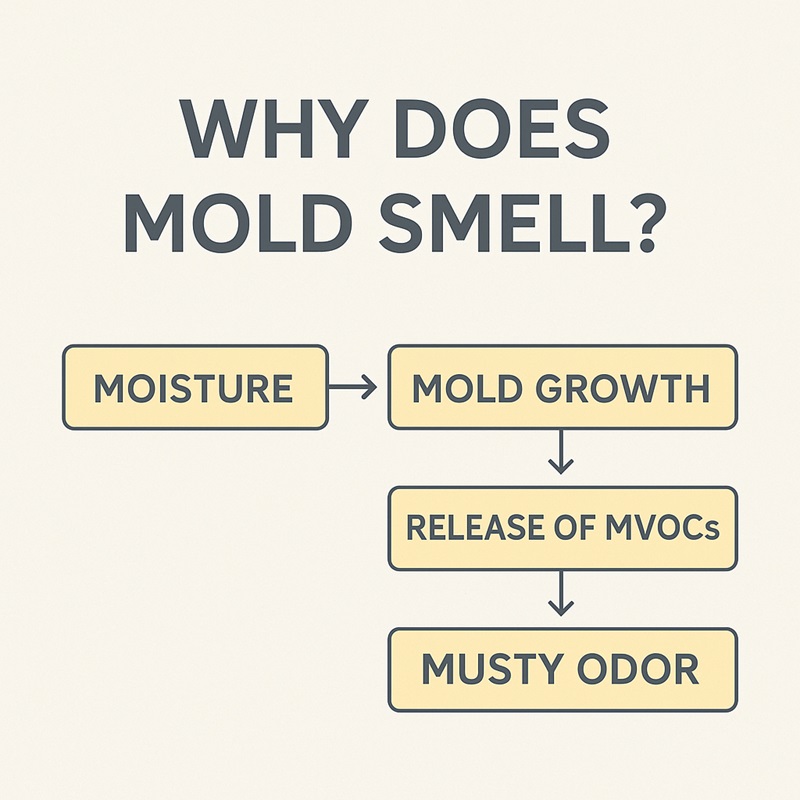Mold is one of the most common yet dangerous problems homeowners face in the USA. It doesn’t just damage walls, carpets, and wood — it can also threaten your health. The tricky part is that mold often hides where you can’t see it: behind drywall, under floors, or inside HVAC systems. But before you see it, you’ll often smell it first.
So, what does mold smell like, and how can you recognize it early? Let’s break down the odors, risks, and steps you need to take before this toxic threat spreads through your home.
What Does Mold Smell Like? (Quick Answer)
Mold usually smells musty, earthy, and damp — similar to:
- Wet socks that never dried properly
- Old books stored in a humid attic
- Rotting wood or leaves in a pile after rain
Some molds give off a sharper, sour odor, while toxic black mold may smell more pungent or rotten. If your home has an odor that lingers and won’t go away even after cleaning, it could be a sign of hidden mold.
The Science Behind Mold Smells
Mold gives off gases called microbial volatile organic compounds (MVOCs) as it grows. These gases mix with the air inside your home and create that musty smell. If the odor is strong, it usually means the mold is active and spreading.
Moisture, leaks, and poor airflow make the smell appear quickly—sometimes within just 1–2 days after water damage.
Why Does Mold Smell?
That musty odor is more than just unpleasant—it’s a warning sign. Mold smells because it breaks down materials like wood, paper, fabric, and drywall, releasing gases into the air.
The strength and type of odor depend on:
- Moisture: Damp areas make mold grow faster and smell stronger.
- Material: Mold on wood may smell different than mold on fabric or food.
- Ventilation: Poor airflow traps mold gases, making the odor last longer.
- Mold Type: Some molds smell musty, while black mold can smell sharp, sour, or ammonia-like.
Health experts, including the EPA and CDC, note that a musty smell is often the first clue to hidden mold growth. Even if you don’t see it, the odor means colonies may be growing inside your home.
In short: mold smells because it’s alive, spreading, and releasing gases. That smell is your signal to act before the problem gets worse.
Common Descriptions of Mold Smell
Musty and Damp – The Classic “Basement” Smell
This is the odor most people connect with mold. It smells heavy and stale, like wet socks or old cardboard in a damp space. Basements and crawl spaces often carry this smell because they are cool, moist, and poorly ventilated.
If you notice this odor, it often means mold is active on wood, paper, or drywall. The EPA warns that steady musty smells should always be treated as a red flag, even if no mold is visible.
Earthy or Soil-Like – Similar to Wet Dirt or Leaves
Some molds smell like wet soil, rotting leaves, or a damp forest. People sometimes mistake this odor for natural “outdoor” air drifting inside.
But if the smell is strong in one spot indoors—around windows, in attics, or behind walls—it often points to hidden leaks or condensation. The CDC notes that earthy odors are strongest near water-damaged areas.
Rotten or Sour – Linked to Black Mold
Certain molds, including black mold (Stachybotrys chartarum), produce sharp, foul odors. These may smell like rotting food, sour milk, or even ammonia.
If your home smells like rotten food or animal urine without a clear source, mold may be hiding inside walls, insulation, or HVAC systems. These odors should not be ignored, as toxic mold can harm health—causing breathing issues, fatigue, or other problems.
Sweet or Fermented – Rare but Possible
Some molds smell sweet, like alcohol or spoiled fruit. People may confuse this with spilled drinks or overripe food.
These odors usually come from hidden mold colonies in kitchens, behind appliances, or in air ducts. The AIHA explains that these smells come from special gases called MVOCs, unique to certain molds. Catching them early may stop mold before it spreads further.

Where Homeowners Are Most Likely to Smell Mold
Mold thrives in areas with moisture, warmth, and poor airflow. Common problem spots include:
- Basements & Crawl Spaces: Damp, dark, and often poorly ventilated.
- Bathrooms: Under sinks, behind tiles, or around bathtubs.
- Kitchens: Behind refrigerators, dishwashers, or under sinks.
- HVAC Systems: Mold spores can grow in ducts and circulate throughout your home.
- Inside Walls & Attics: Roof leaks or plumbing issues often lead to hidden mold.
Mold Smell vs. Mildew Smell
Mold and mildew are both fungi, and their odors often confuse homeowners. But knowing the difference matters because mold is usually more serious than mildew.
Mildew: Light, Powdery, and Easy to Clean
Mildew gives off a lighter, less strong smell. People often compare it to stale or damp air. It grows on the surface of wet spots, like shower tiles, bathroom walls, or damp fabrics.
Because it stays on the surface, mildew is easier to clean with simple household products like vinegar or diluted bleach.
- Odor Clues: Gentle, musty, “stale closet” smell.
- Appearance: White or gray patches spreading outward.
- Action: Wipe away quickly; improve ventilation to stop it from coming back.
Mold: Stronger, Deeper, and More Harmful
Mold smells much stronger and more unpleasant. Many describe it as heavy, earthy, or rotten. Unlike mildew, mold grows into building materials like drywall, wood, or insulation, which makes it hard to remove.
Some types, such as black mold (Stachybotrys chartarum), release especially foul odors that may signal a toxic variety.
- Odor Clues: Lingering, strong, musty, sometimes rotten or ammonia-like.
- Appearance: Black, green, or dark fuzzy patches, often spreading below surfaces.
- Action: Call professionals if the smell continues or if growth is widespread.
Key Differences at a Glance
| Feature | Mildew | Mold |
| Odor | Light, stale, less pungent | Strong, musty, sometimes sour or rotten |
| Growth | Surface-level (tiles, fabrics) | Deeper, invasive (walls, wood, insulation) |
| Health Impact | Mild irritation for sensitive individuals | Allergies, asthma, toxic effects (depending on species) |
| Cleanup | DIY-friendly with cleaners | Often requires professional remediation |
If the odor is faint and surface-level, it’s probably mildew. If the smell is strong, persistent, and seems to linger in the air no matter what you clean, it’s far more likely mold.
Odors That Are Similar to Mold but Aren’t Mold
Sometimes homeowners panic when they smell something odd, assuming it’s mold. But several common household odors can mimic mold without actually being caused by fungal growth. Knowing the difference can save time, money, and stress.
1. Damp Laundry or Wet Fabrics
Clothes left in the washer too long can smell musty and stale, very similar to mold. The odor comes from bacterial growth in damp fabric, not mold colonies on your walls.
Tip: If the smell is localized to laundry or towels and disappears after a hot wash, it’s likely not mold.
2. Stale Air in Poorly Ventilated Rooms
A room that’s been closed for days — especially basements or attics — can develop an old, musty odor even without mold. This is due to stagnant air, dust, and humidity.
Tip: Open windows, run fans, or use an air purifier. If the odor fades, it was stale air, not mold.
3. Pet Odors or Litter Boxes
Animal urine, especially from cats, can give off an ammonia-like smell that homeowners sometimes confuse with toxic mold.
Tip: Clean the area thoroughly and see if the odor persists. Mold smells usually linger even after cleaning.
4. Gas Leaks or Plumbing Issues
Natural gas and certain plumbing leaks can create sour or sulfur-like odors, which may be mistaken for mold.
Tip: If the smell is sharp, chemical, or sulfur-like, contact a plumber or gas company immediately — don’t assume it’s just mold.
5. Food Spoilage
Rotting fruits, vegetables, or forgotten leftovers in a pantry or fridge can release fermented, musty, or sour odors.
Tip: Check kitchens and pantries first — food spoilage smells disappear once the source is removed.
Why This Distinction Matters
While these smells can be unpleasant, they aren’t always a sign of hidden mold. However, if you’ve ruled out laundry, pets, food, or stale air and the musty odor still lingers, it’s time to consider a mold inspection.
Why Mold Smell Shouldn’t Be Ignored
A musty smell isn’t just an inconvenience — it’s often the first warning of a bigger problem.
- Health Risks: Mold exposure can trigger allergies, asthma, sinus irritation, headaches, and even toxic reactions depending on the type of mold.
- Structural Damage: Mold eats away at wood, drywall, carpet, and insulation.
- Property Value: Persistent mold odor can discourage buyers and reduce your home’s resale value.
What to Do If You Smell Mold but Don’t See It
- Inspect Common Areas: Check basements, bathrooms, under sinks, and around windows.
- Use Tools: A moisture meter or mold test kit can help locate hidden colonies.
- Check HVAC Systems: Mold in ducts often produces a musty smell throughout the house.
- Call a Professional: If the odor persists and you can’t locate the source, contact a mold remediation specialist.
Read : Does Bleach Kill Mold?
Prevention: Keeping Mold Away From Your Home
- Control Humidity: Keep indoor humidity below 50% using dehumidifiers.
- Improve Ventilation: Run fans in bathrooms and kitchens.
- Fix Leaks Quickly: Don’t let plumbing or roof leaks sit.
- Clean Regularly: Wipe down damp areas and keep basements dry.
FAQs
Q: Does black mold smell different?
Yes. Black mold often produces a stronger, more pungent odor — sometimes described as rotten or ammonia-like.
Q: Can mold smell make you sick even if you can’t see it?
Absolutely. Inhaling mold spores from odor-producing colonies can cause allergic reactions and respiratory issues.
Q: How long does it take for mold smell to appear?
Mold can begin producing odors within 24–48 hours after water exposure.
Conclusion
If you’ve noticed a musty, earthy, or rotten smell in your home, don’t ignore it. Mold odors are often the first warning sign of a toxic problem hiding behind walls, under carpets, or inside your HVAC system.
By acting quickly — inspecting your home, reducing moisture, and calling in professionals when necessary — you can stop mold before it spreads, protect your health, and preserve your property value.
Bottom line: If your house smells like mold, it’s time to act before the toxic threat grows.





